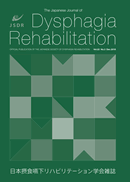Volume 26, Issue 2
The Japanese Journal of Dysphagia Rehabilitation
Displaying 1-8 of 8 articles from this issue
- |<
- <
- 1
- >
- >|
Original Paper
-
2022Volume 26Issue 2 Pages 87-98
Published: August 31, 2022
Released on J-STAGE: December 31, 2022
Download PDF (480K) -
2022Volume 26Issue 2 Pages 99-108
Published: August 31, 2022
Released on J-STAGE: December 31, 2022
Download PDF (597K) -
2022Volume 26Issue 2 Pages 109-120
Published: August 31, 2022
Released on J-STAGE: December 31, 2022
Download PDF (456K)
Short Communication
-
2022Volume 26Issue 2 Pages 121-127
Published: August 31, 2022
Released on J-STAGE: December 31, 2022
Download PDF (364K) -
2022Volume 26Issue 2 Pages 128-139
Published: August 31, 2022
Released on J-STAGE: December 31, 2022
Download PDF (685K)
Case Report
-
2022Volume 26Issue 2 Pages 140-146
Published: August 31, 2022
Released on J-STAGE: December 31, 2022
Download PDF (711K)
Clinical report
-
2022Volume 26Issue 2 Pages 147-151
Published: August 31, 2022
Released on J-STAGE: December 31, 2022
Download PDF (349K)
Investigation report
-
2022Volume 26Issue 2 Pages 152-160
Published: August 31, 2022
Released on J-STAGE: December 31, 2022
Download PDF (624K)
- |<
- <
- 1
- >
- >|
